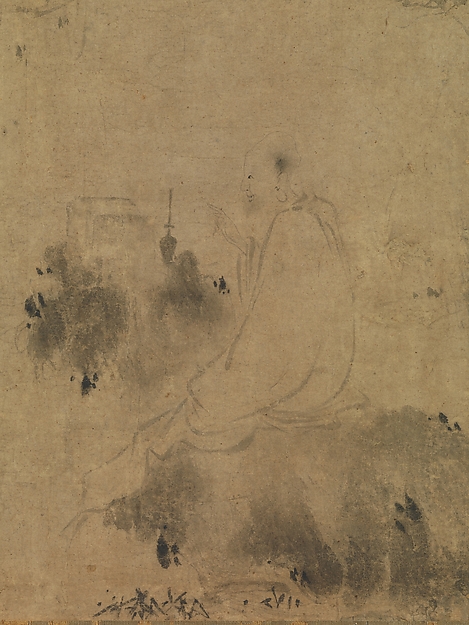 |
| Esta pintura fue inscripta por el sacerdote Chan (Zen) budista Yanxi Guangwen entre 1254 y 1256, mientras él era abad del templo Lingyin en Hangzhou. El trabajo es un ejemplo importante de la temprana pintura budista Chan "aparición", llamado así por su pálida, pincelada delicada. Se representa aquí un famoso encuentro entre el erudito confuciano Li Ao (ca. activa 840) y el maestro Chan Yaoshan. Después de haber oído hablar de la reputación del maestro, el sabio fue a verlo, pero estaba decepcionado y comentó: ". Al ver su cara no es tan buena como su renombre" El maestro respondió: "¿Desconfias de tu ojo y el valor de tu oído?" Luego, hacia arriba y hacia abajo, el maestro indicó que la realidad última está en lo que se ve, por ejemplo, "las nubes en el cielo y el agua en un jarrón." La inscripción de Yanxi Guangwen en la pintura lee: Todos los momentos de iluminación vienen en una flash, ¿Por qué desconfiar de su ojo y el valor de su oído? Al igual que entre el agua y las nubes, no digas que no hay nada allí. Así como el maestro Chan utiliza acertijos para agudizar la percepción del alumno, a pesar de los rumores de distracción, el pintor Chan utiliza un estilo sencillo y espontáneo, aunque difícil de alcanzar, estilo cepillo para capturar su visión fugaz de la verdad. |
Depicted here is a famous encounter between the Confucian scholar Li Ao (active ca. 840) and the Chan master Yaoshan. Having heard of the master's reputation, the scholar went to see him but was disappointed and remarked: "Seeing your face is not as good as hearing your name." The master replied: "Would you distrust your eye and value your ear?" Then, pointing up and down, the master indicated that the ultimate reality is in what can be seen, such as "clouds in the sky and water in a vase."
Yanxi Guangwen's inscription on the painting reads:
All moments of enlightenment come in a flash,
Why distrust your eye and value your ear?
Just as between the water and the clouds,
Do not say there is nothing there.
Just as the Chan master used riddles to sharpen the student's perception in spite of distracting hearsay, the Chan painter used a simple and spontaneous, albeit elusive, brush style to capture his fleeting vision of truth.
No hay comentarios:
Publicar un comentario